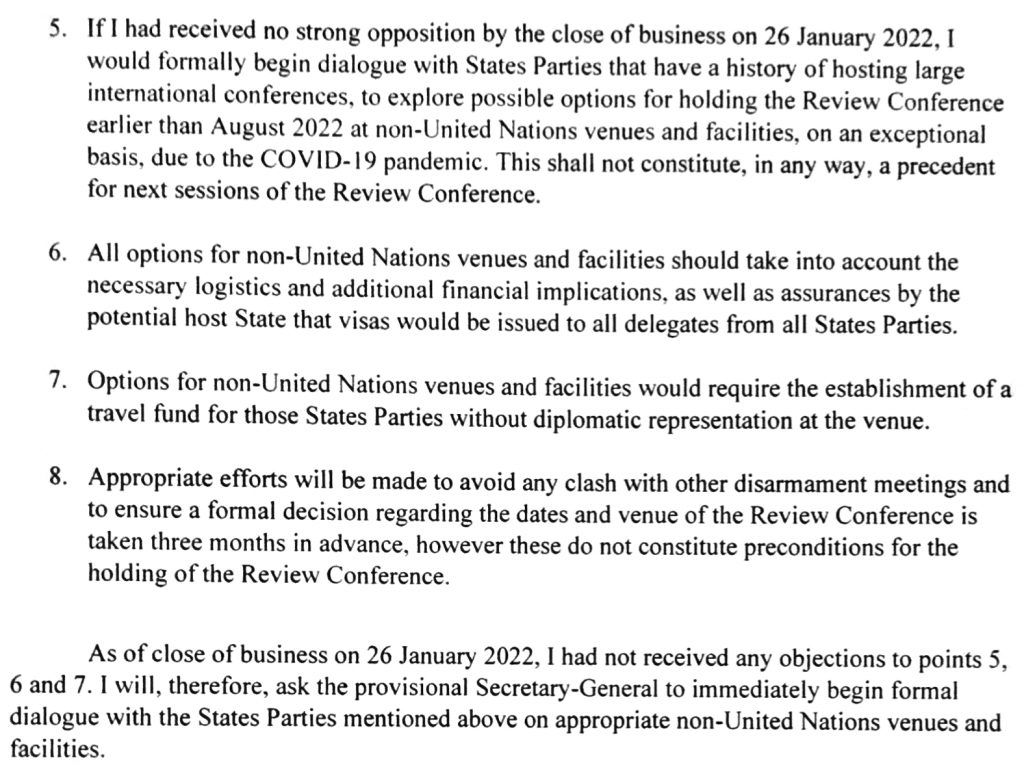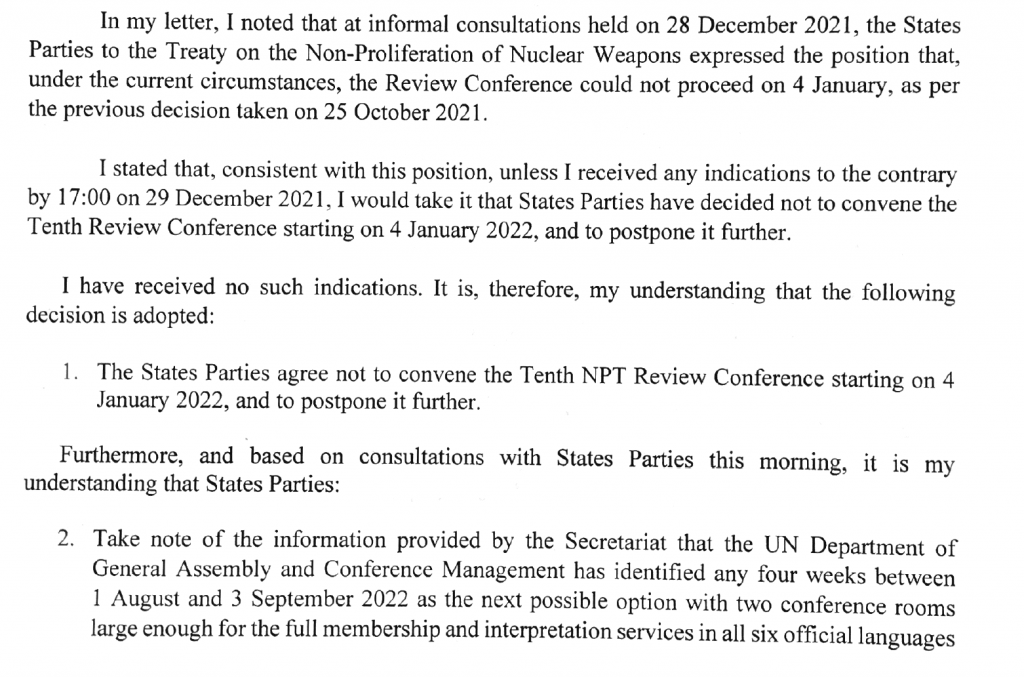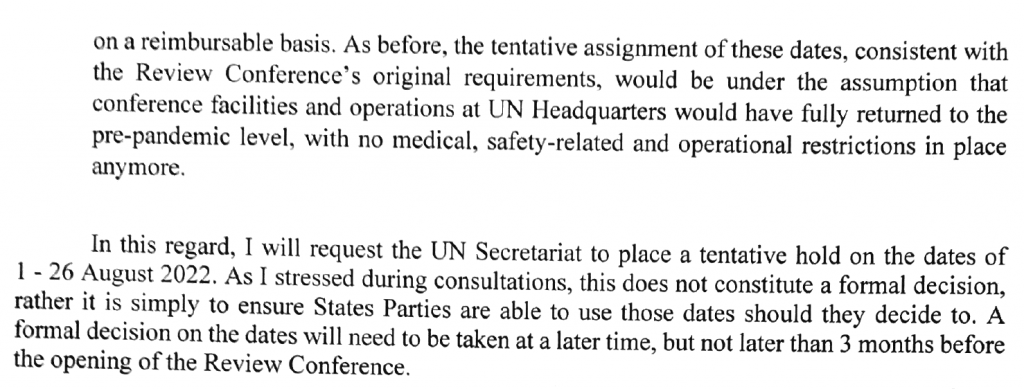
You can find it here:


You can find it here:
From an Indian statement to the CD the other day:
India had welcomed the joint statement by the P-5 leaders, which reaffirmed the importance of addressing nuclear threats and underscored the desire to work towards creating a security environment more conducive to progress on disarmament with the ultimate goal of a world without nuclear weapons with undiminished security for all. As a responsible nuclear weapon State, India had a doctrine of maintaining a credible minimum deterrence based on a no first use posture and non-use of nuclear weapons against non-nuclear weapon States.
On 12 January , the Iranian government published a profile titled Iran’s first nuclear martyr: A look at the life of Massoud Ali Mohammadi.
This seems to be the most relevant paragraph:
Massoud knew the methodology for carrying out scientific studies very well. He was not ashamed to ask questions and he always sought to increase his knowledge. In addition to physics, he was knowledgeable about philosophy and cosmology as well. Fereydoun Abbasi, the head of the Atomic Energy Organization of Iran at that time, said the following about him, “Sometimes students would sit in my room and engage in discussions with each other. He would sit with them, listen and ask questions as well. He met Dr. Rezainejad here. He had very good scientific discussions with him, and in some cases, he would raise objections to him.” He knew mechanics in the field of physics and that is why he was actively and effectively involved in the initial studies for uranium enrichment, centrifuge design and construction.
Thought it was worth mentioning Pakistan’s reaction to the Joint Statement of the Leaders of the Five Nuclear-Weapon States on Preventing Nuclear War and Avoiding Arms Races:
The Joint Statement by the P-5 on Preventing Nuclear War and Avoiding Arms Races is a positive development. This understanding among the permanent members of the UN Security Council can pave the way for concrete measures for strategic stability at the global and regional levels.
As a responsible nuclear weapons State, Pakistan supports the objectives of global and non-discriminatory nuclear disarmament and non-proliferation, in line with the stipulations of the First Special Session on Disarmament of the UN General Assembly (SSOD-I) – with equal and undiminished security being the defining consideration.
The P-5 statement rightly acknowledges the imperative of creating conducive security environment for meaningful progress on nuclear disarmament. This will include addressing the underlying security concerns of States, pacific settlement of outstanding disputes, and cessation of destabilizing arms build ups that accentuate asymmetries.
In the context of South Asia, Pakistan’s proposal for a Strategic Restraint Regime, encompassing nuclear and missile restraint, conventional balance and settlement of disputes, can contribute significantly towards maintaining strategic stability and avoiding military conflict. This will also entail eschewing misplaced notions of space for war in a nuclearized environment.
Pakistan fully agrees with the need for effective measures by all nuclear powers to guard against any unauthorized or unintended use of nuclear weapons.
Pakistan’s MFA spokesperson said this:
You would have seen our response to media queries on the P-5 Joint Statement on Preventing Nuclear War and Avoiding Arms Races. It is a positive development. However, as noted in the statement itself, the realization of the objective of global disarmament will require a conducive security environment. This can only happen through cessation of destabilizing arms build-ups and addressing asymmetries, settlement of disputes and commitment to strategic stability rather than competition.
In his book Betrayal, Jonathan Karl reports about this U.S. assessment concerning Iran’s nuclear weapons capability:
Despite the IAEA’s assessment that Iran could have enough fuel for two nuclear bombs within six months, the U.S. military’s assessment was that Iran was still twelve to eighteen months away from having the capacity to make a nuclear weapon.
Off-topic, but I feel the need to highlight the below portion of. this 1995 LRB article (behind paywall, I think)::
On 24 September 1940, shortly after 9 p.m., those British radio listeners who had tuned their sets to 213 metres on the medium wave (a little higher than the frequency of the BBC Home Service) were in for a shock. ‘Have you ever seen Beaverbrook?’ asked one of the announcers, referring to the current Minister for Aircraft Production. ‘Well, we often have in meeting halls, and what we could never understand was, why he was on the platform instead of swinging from one chandelier to another … He’s a miserable little coward and the best way of dealing with a bloody fucker like him is to get hold of him personally and give him a good beating which he won’t forget.’ This attack on Lord Beaverbrook, which must have sent a frisson of delighted horror through its listeners, was something of a milestone in broadcasting history, for it was the first time that the word ‘fuck’ had been transmitted to a British radio audience.
There was something else peculiar about this programme. Even a casual listener could tell that the station, which announced itself as Workers’ Challenge, did not belong to the BBC, although it claimed to be broadcasting from within the British Isles. As most of its regular listeners knew, Workers’ Challenge was a German propaganda station, whose programmes were produced by the Büro Concordia, part of the Foreign Service of the Nazi broadcasting organisation, the Reichsrundfunk. As Adrian Weale describes in his Renegades: Hitler’s Englishmen, Workers’ Challenge was the responsibility of Büro S, and at the time of this historic broadcast the announcers were Sergeant MacDonald and Guardsman William Humphrey Griffiths of the British Army, both recruited from German prisoner-of-war camps. While broadcasting for Büro S, they lived in an apartment in Berlin, wore civilian clothes, were provided with supplies of tobacco and alcohol and, if they liked, were escorted once a week to a nearby brothel.
The announcers of Büro S thus lived quite different lives from their counterparts at the BBC, but then the programmes they broadcast were also quite different. The attraction of Workers’ Challenge lay not only in the fact that its announcers spoke in working-class regional accents, but also that they swore constantly. According to their characteristic style, the ‘bloody government’ was soon going to lose ‘the bloody war’, at which point ‘Churchill and his buggers will clear off.’ For listeners raised on the sedate broadcasts of the Home Service, whose announcers wore evening dress and were required to speak what was called ‘educated English’, this was a distinct novelty. As one BBC listeners’ report admitted, Workers’ Challenge had built up a significant audience, for ‘people switch on to hear the swear words.’ ‘Old ladies in Eastbourne and Torquay are listening to it avidly,’ admitted another official, ‘because it is using the foulest language ever. They enjoy counting the Fs and Bs.’
Well. This 1998 CNN piece, citing “the latest information from U.S. intelligence sources.,” reports that
Pakistani workers at a test site near the Iranian border have put a nuclear device in a shaft and encased it in concrete. The process, known as “stemming,” would make it difficult to retrieve the device without detonating it.
I like the reaction from then-Foreign Minster Gohar Ayub Khan:
“All intelligence offices of any worth will cover themselves by saying ‘probably,’ ‘possibly,’ ‘if,’ ‘maybe,’ ‘perhaps,'” Khan said. “They have no information as such. What they’re trying to do is make an intelligent guess.”
However, Khan said “nothing whatsoever” was keeping Pakistan from proceeding with a test, and that it was not a case of if Pakistan would conduct a test but when.
Asked when a test might occur, Khan responded, “You want me to be hung? These are not the sort of things one gives on television.”
It seems reasonable to post this letter from Gustavo Zlauvinen concerning the RevCon which was meant to have begun today.
Here’s the relevant part:


If a death occurs while you are confined to the fall-out room place the body in another room and cover it as securely as possible. Attach an identification.
This report to the UNSC from the Special Adviser and Head of the United Nations Investigative Team to Promote Accountability for Crimes Committed by Da’esh/Islamic State in Iraq and the Levant contains an update about ISIS’s use of chemical and biological weapons. [Link fixed.]
Summary paragraph:
Investigations by the Team into the use of chemical and biological weapons by ISIL in Iraq have also moved forward rapidly. Based on testimonial, digital, documentary and forensic evidence, the Team has identified approximately 3,000 potential victims and witnesses of chemical weapons attacks carried out by ISIL. Analysis of previously unaccessed internal ISIL documentation on its chemical weapons programme shows the strategic planning undertaken in anticipation of the development of such weapons, including the use of Mosul University as a centre for research and development.
The investigation focuses on a March 2016 attack on Tazah Khurmatu and a June 2014 ISIS takeover of the University of Mosul and its “subsequent repurposing in support of a weapons development programme.”
Investigations in relation to attacks in Tazah Khurmatu have confirmed that on 8 March 2016, the district was struck by numerous rocket artillery projectiles containing a sulfur mustard agent, resulting in serious injuries and loss of life, the destruction of property and long-term repercussions for human health and the environment. Key pieces of documentary, testimonial and digital evidence analysed include laboratory results from samples obtained during clean-up operations of contaminated sites, forensic data associated with recovered weapon remnants, medical records and medical admissions data, autopsy reports in specific cases involving child victims, and analysis of the specific characteristics of the chemical payload.
The analysis of internal ISIL documents has supported the identification of key ISIL organizational structures as well as specific ISIL members having knowledge of, and a potential leadership role in, the attacks on Tazah Khurmatu, along with others performing more facilitative or operational roles. A significant number of additional witnesses have also been identified, including first responders and medical professionals, survivors of the attack and other affected families.
<snip>
With respect to the takeover of Mosul University by ISIL, investigations have confirmed that specific laboratories and workshops within the biology and chemistry buildings of the University College of Sciences were utilized to facilitate the systematic research, development and production of mustard and other weaponized substances.
Internal ISIL documents obtained by the Team have confirmed the modification of university curricula and the employment by ISIL of small teams of qualified technical and scientific experts, notably in the fields of chemistry and physics, to pursue the weaponization of specific chemical and biological substances on the university campus. Chemical stores at the University, including a specific chemical depository in the College of Medicine, appear to have been accessed by ISIL subsequent to 10 June 2014. These initial findings will inform priority areas of forthcoming inquiry, including the analysis of identities of and relationships between those contributing to the overall programme, their specific research focus, and the degree of progress made in each case.